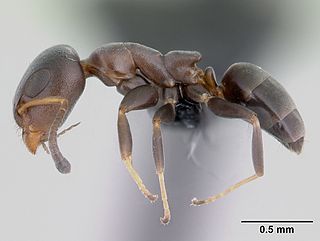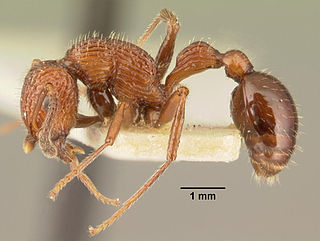
Dolichoderinae is a subfamily of ants, which includes species such as the Argentine ant, the erratic ant, the odorous house ant, and the cone ant. The subfamily presents a great diversity of species throughout the world, distributed in different biogeographic realms, from the Palearctic, Nearctic, Afrotropical region and Malaysia, to the Middle East, Australian, and Neotropical regions.

Turneria is a genus of ants that belongs to the subfamily Dolichoderinae. Known from Australia, they form small colonies of fewer than 500 workers, and nest in trees and twigs.

Crematogaster is an ecologically diverse genus of ants found worldwide, which are characterised by a distinctive heart-shaped gaster (abdomen), which gives them one of their common names, the Saint Valentine ant. Members of this genus are also known as cocktail ants because of their habit of raising their abdomens when alarmed. Most species are arboreal. These ants are sometimes known as acrobat ants.

Acropyga is a genus of small formicine ants. Some species can be indirect pests. A. acutiventris, which is found from India to Australia, tends subterranean, root-feeding mealybugs of the species Xenococcus annandalei. Living, gravid females are carried in the jaws of A. acutiventris queens during their nuptial flight, to establish the symbiotic association in founding colonies. Other Acropyga species have relationships with different species of mealybugs, and it could be a trait common to the whole genus.

Romblonella is a genus of myrmicine ants.

Stereomyrmex is a genus of myrmicine ants. Two of the described species are known from only a single worker, making this one of the rarest groups of ants in the world.
Morturneria is an extinct genus of plesiosaur from the Late Cretaceous of what is now Antarctica.
Nurteria is a genus of flies in the family Dolichopodidae, found in the Afrotropical realm. Three species are currently known in the genus, but there are also numerous undescribed species of the genus from southern Africa. It was originally described in the subfamily Diaphorinae, though it possesses some features of the Sympycninae.

William Montana Mann (1886–1960) was an American entomologist and the fifth director of the National Zoo in Washington, D.C. from 1925 until 1956. In 1921, he traveled on the Mulford Expedition to the Amazon. In 1926, he married Lucile Quarry Mann. The two worked together as a team to improve and promote the zoo, including going on expeditions around the world to collect live specimens for the zoo's collection. He graduated from Washington State University and Harvard University.

Poecilomyrma is a genus of ants in the subfamily Myrmicinae. Its two species are restricted to the Fijian archipelago. Although rare, the genus is known from all seven of the largest islands of Fiji.

Lordomyrma is a genus of ants in the subfamily Myrmicinae.

Vollenhovia is a genus of ants in the subfamily Myrmicinae.

Parvaponera is a genus of ants in the subfamily Ponerinae. The genus is distributed in Africa, Southeast Asia, Australia and the Solomon Islands. Workers are slender and small in size. Queens are similar to workers, but larger and winged.
Turneria arbusta is a species of ant in the genus Turneria. Described by Shattuck in 1990, the species is endemic to Papua New Guinea.

Turneria bidentata is a species of ant in the genus Turneria. Described by Forel in 1895, the species is endemic to Australia, mostly found in the north ends of the country.
Turneria collina is a species of ant in the genus Turneria. Described by Shattuck in 1990, the species is endemic to Papua New Guinea.
Turneriapostomma is a species of ant in the genus Turneria. Described by Shattuck in 1990, the species is endemic to Papua New Guinea.
Turneria dahlii is a species of ant in the genus Turneria. Described by Forel in 1901, the species is endemic to New Guinea, the Solomon Islands and Vanuatu.
Turneria frenchi is a species of ant in the genus Turneria. Described by Forel in 1911, it is endemic to Australia, but original specimens of the ant have been lost, and its placement in a genus has been in question. The ant has been transferred various times, notably being transferred to Stigmacros in 1990 but then put back into Turneria in 1992.
Phasmaphleps is a genus of flies in the family Dolichopodidae from the western Pacific. It contains only one species, Phasmaphleps pacifica, which occurs in the Samoan Islands, Tonga, Fiji, Solomon Islands, Tuvalu and Palau.











